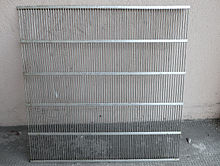Barrier (beekeeping)
A barrier is a metal or plastic grille inside a beehive that separates the brood chamber from the honey chamber for the queen bee . The bars are 4.2 millimeters apart, which can only be passed by the smaller worker bees , but not by the larger queens and male drones .
The barrier was probably invented around 1890. The point is that the queen cannot move from the brood room to the honey room. There she would lay her eggs between storage cells with honey, so that bee larvae or eggs would get into the honey when it was flung.
Barriers are used for back- treatment hives and magazine hives . You are not in the bee colony all year round, but only after setting up the honey room during the foraging period during spring and summer. It is intended to prevent the larger queen from coming into the honey room to create brood there. This ensures that the honey room remains brood-free.
Some beekeepers do not use the safety gate because they see it as an obstacle to the natural development of the beehive.
literature
- Gerhard Liebig: Simply beekeeping . Self-published, Aichtal 2nd edition 2002, p. 26ff.
- Franz Lampeitl: Keeping bees . Ulmer Verlag, Stuttgart 1982, ISBN 3-8001-7075-2 .

